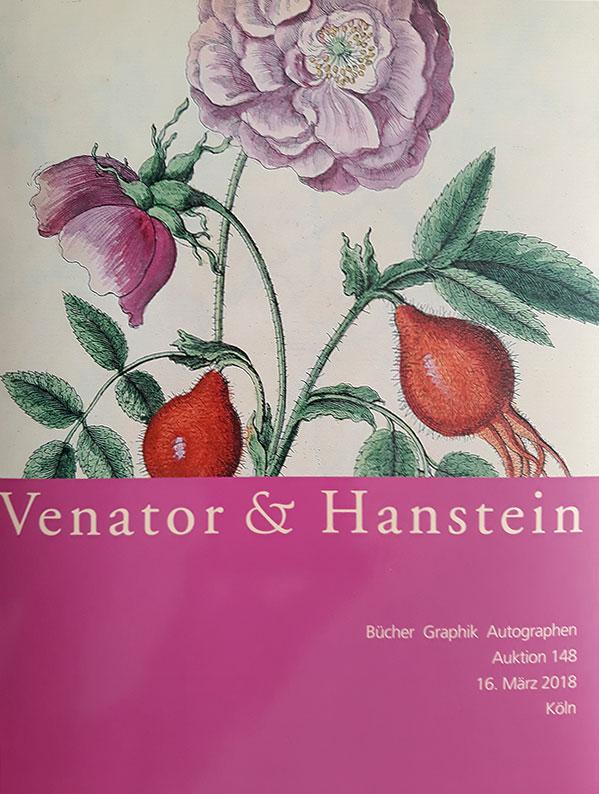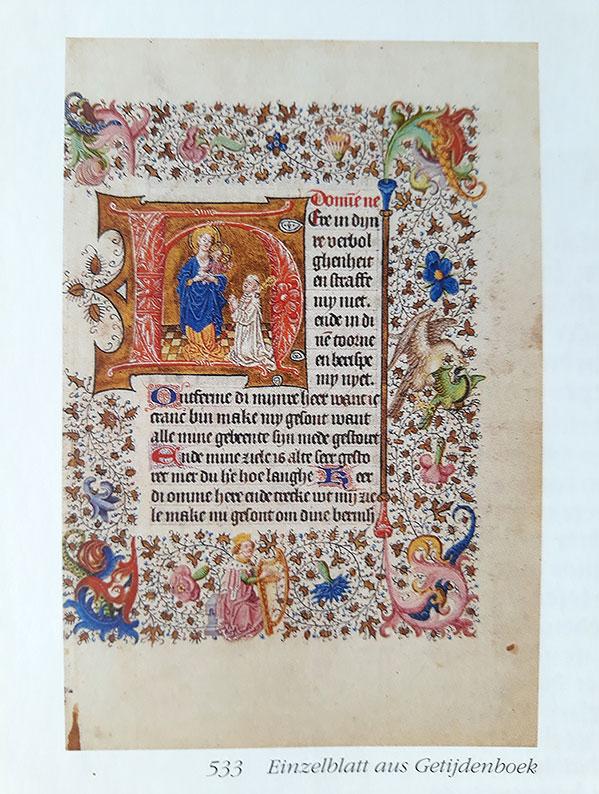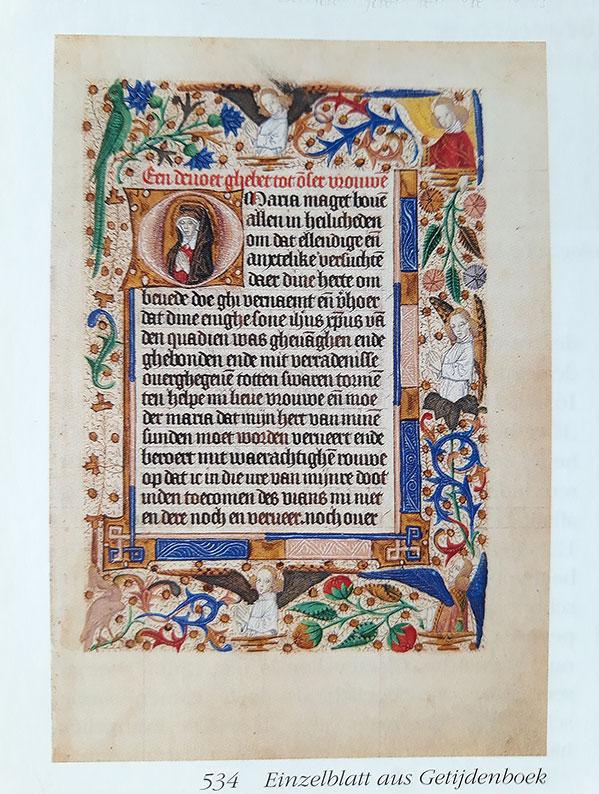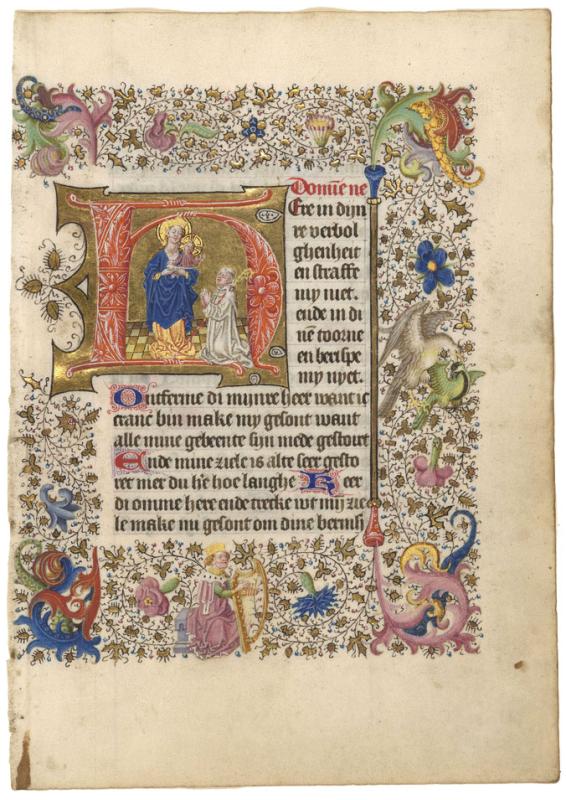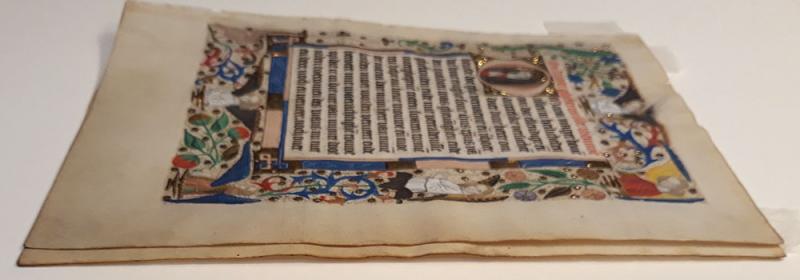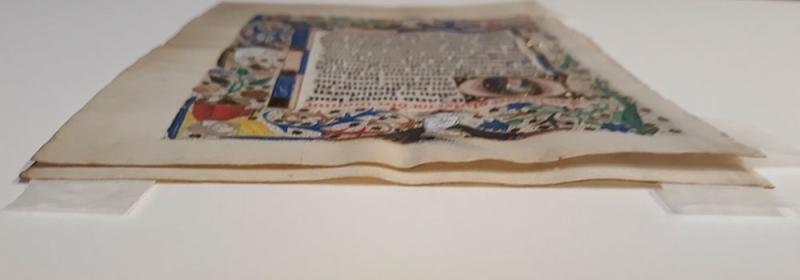Late on a January afternoon in 2018, I was looking at the offerings of books, prints, and manuscripts in a catalogue for a forthcoming sale at the auction house of Venator & Hanstein in Cologne. At lot 533, my eyes nearly popped out of their sockets. “This is impossible,” I thought, “This can’t be what I think it is.” The lot was a “single leaf from a Book of Hours” in Dutch with a large historiated initial and a decorative border that marked the start of the Penitential Psalms. I kept having to rub my eyes, not believing what I was seeing; at 4:30 in the afternoon my blood sugar was low, and I was in desperate need of a Diet Pepsi. The illumination on the leaf was by the Master of Catherine of Cleves—I had recognized his hand in a nanosecond. How could the auction house not know this? The estimate was a mere €350.
In 1963 and then in 1970, the Pierpont Morgan Library, in a brilliant double coup of acquisition, bought both volumes of the Hours of Catherine of Cleves. This is the (still anonymous) artist’s masterpiece and the book that gave him his nickname. Catherine’s manuscript had been broken up in the nineteenth century by a dealer who then shuffled the leaves, creating two volumes, both of which looked more or less complete. (Each volume contained around seventy miniatures, many more than the number in a typical Book of Hours.) In 1966, George Braziller published a facsimile of the manuscript, a copy of which I acquired in the 1970s as a graduate student. This book made me familiar with the artist and his style long before I joined the Morgan’s staff in 1989. I included the manuscript in my 1997 exhibition, Medieval Bestseller: The Book of Hours, and in its publication, Painted Prayers. In 2010, I was the curator of Demons and Devotion: The Hours of Catherine of Cleves, a show that displayed almost all of the miniatures from the two volumes, which had been disbound with a view to rebinding the shuffled leaves in their original, fifteenth-century order. Having thus “lived” with the artist and his masterpiece for many years, I spotted his characteristic style on the leaf in the Venator & Hanstein catalogue instantaneously.
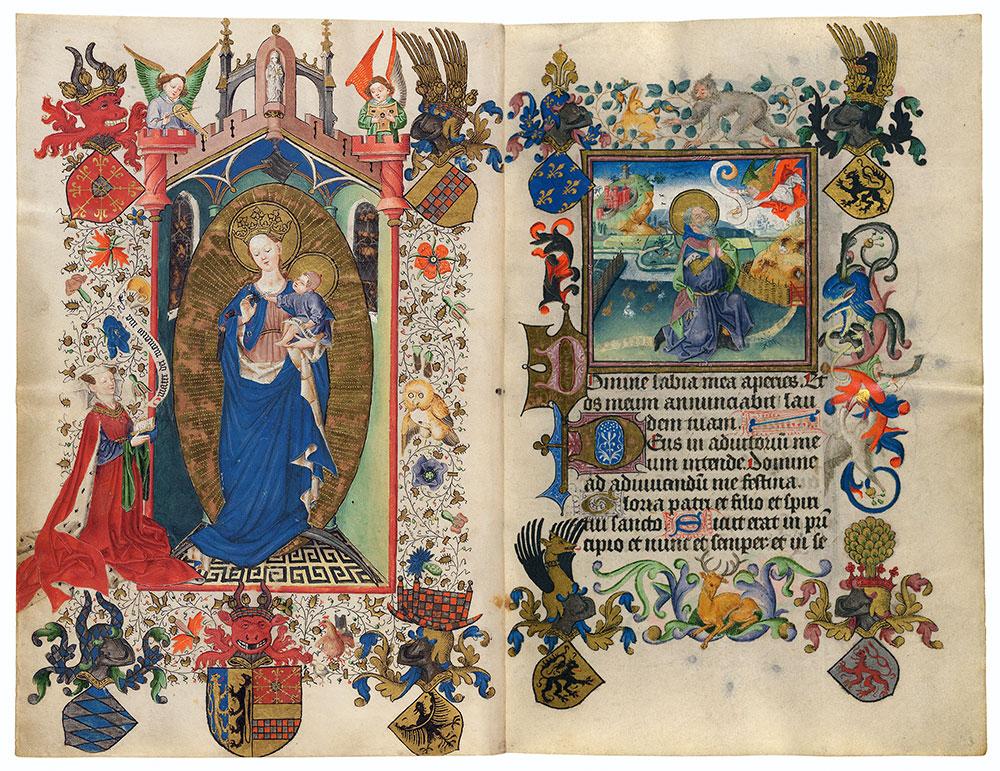
Virgin and Child Adored by Catherine of Cleves and Annunciation to Joachim, Hours of Catherine of Cleves, The Netherlands, Utrecht, ca. 1440, illuminated by the Master of Catherine of Cleves; MS M.917/945, fols. 1v–2. Purchased on the Belle da Costa Greene Fund and through the generosity of the Fellows, 1963 and 1970.
Suspecting that the leaf was a missing page from one of the known Books of Hours illuminated by the artist, I checked the literature and online sources. Of the fourteen known manuscripts painted by the artist, eight are Books of Hours. None of them, however, was missing its introductory Penitential Psalms leaf. Investigating these Horae, I was struck by the similarity between the style and decoration of the leaf to that employed by the artist in his so-called Lochorst Hours in The Hague (Museum Meermanno, MS 10 F 50). The leaf and the Hours, for example, share a similar standing Virgin Mary (with distinctive musculature at the throat), similar birds in the borders, and nearly identical bars sprouting foliage that has a distinctive center element covered with circles like an octopus tentacle. The Lochorst Hours has been considered the last work by the artist, datable to ca. 1460. The book also contains miniatures by the Flemish illuminator Lievan van Lathem; this suggests either a collaboration between the two artists or the possibility that the Cleves Master died while the book was in progress and van Lathem was tapped to finish it. The similarities between the leaf and the Lochorst Hours made the former, too, a late work by the artist. Not coming from any of the artist’s fourteen known works, the leaf represents the only surviving fragment from a fifteenth work (or so I thought at the time).
I “pitched” the leaf to the Morgan’s director, Colin B. Bailey, who, as convinced as I was by the comparisons to the Lochorst Hours, gave me the green light to try to buy it. I, however, faced a challenge. How to bid? A Morgan curator’s bidding might arouse suspicions within the auction house itself that the leaf was something out of the ordinary. Using an agent, too, might throw a spotlight on the lot. Fortunately, a friend (and member of the department’s visiting committee) volunteered to do the bidding for us. (My non-stop talking about the leaf in the weeks leading up to the sale made this friend so nervous that on the day of the bidding she, unwilling to risk getting stuck in the New York City’s subway, which was experiencing major delays in the spring of 2018, walked the five miles from her Upper West Side apartment to her office in lower Manhattan.) By 10:00 a.m., on the morning of March 16, she had secured the leaf! After paying the bill, she refused reimbursement by the Morgan, thus donating the leaf to us (blushingly, I must admit she gave it in my honor). Not only did we get the only known leaf from a fifteenth manuscript illuminated by the Master of Catherine of Cleves, but we also got it for free. I slipped the illumination into the last two weeks of my exhibition, Now and Forever: The Art of Medieval Time, enabling visitors to compare this late work by the artist to Catherine’s Hours that he painted about twenty years prior.
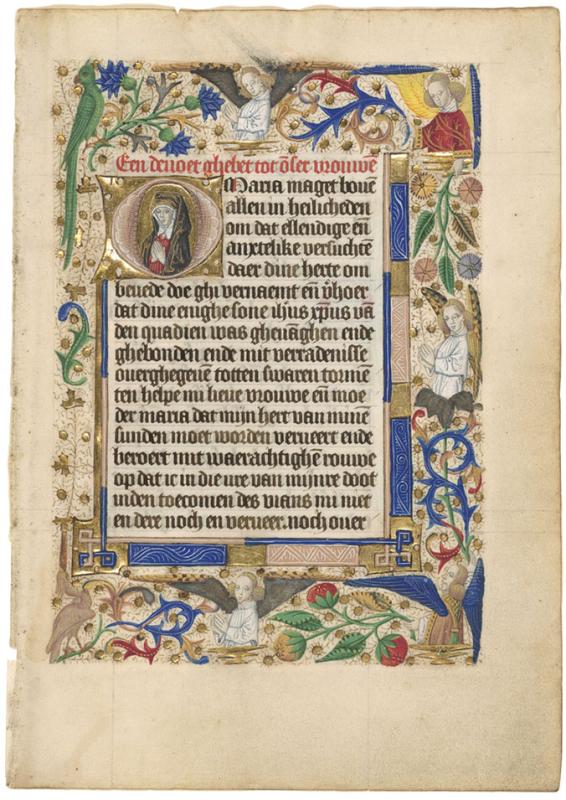
Virgin at Prayer, with a border of angels and birds, single leaf from a Book of Hours, The Netherlands, Utrecht and Delft, ca. 1460–70, illuminated by the Masters of the Delft Half-Length Figures; MS M.1212. Purchased as the gift of Professor James H. Marrow and Dr. Emily Rose in memory of Melvin R. Seiden, 2018.
At the spring meeting of the visiting committee, I proudly displayed the leaf and told the story of its acquisition. When I also showed the Venator & Hanstein catalogue, Jim Marrow (committee chair) pointed to lot 534. “You should have also bought that leaf,” he said, “it’s the finest example of illumination by a Master of the Delft Half-Length Figures I’ve ever seen.” He continued, “In fact, if you find out where it went, I’ll buy it for you.”
Taking a stab, I contacted Phillip J. Pirages Fine Books and Manuscripts, a firm based in McMinnville, Oregon. Indeed, often dealing in single leaves, they had bought lot 534 and were more than happy to sell it. Jim Marrow followed through on his pledge; he and his wife, Emily Rose, bought the leaf for the Morgan in memory of Melvin R. Seiden (founding chair of the visiting committee).
When the leaf by the Delft Half-Length Figures Master arrived at the Morgan, I returned to the Venator & Hanstein catalogue and reread its description. It and the newly acquired leaf by the Cleves Master shared the same dimensions, the same dimensions of their text blocks (written areas), and the same number of lines of text—data I had dismissed as mere coincidence when I first read the lot descriptions back in January. Contacting the auction house, I learned that both leaves had been consigned by the same collector. I discussed these coincidences with Maria Fredericks, Sherman Fairchild Head of the Thaw Conservation Center, with the two leaves in front of us. She noticed that both leaves had similar cockling (minor wavy distortions in the vellum) along their upper and outer edges. Picking up the leaf by the Delft Master, she placed it on top of the Cleves Master’s leaf. They nestled together like sleeping kittens. Plus, their sewing holes lined up. Amazingly, it became clear that the two leaves came from the same book. Thus, like the Lochorst Hours, this “fifteenth manuscript” by the Cleves Master also contained illumination by a second artist. And also like the Lochorst Hours, this new Book of Hours was possibly yet another commission that was in the artist’s studio at the time of his death and thus had to be finished by another artist.
By the end of this roller-coaster ride, I felt as if I had lived a curator’s dream. To find a previously unknown work by one of the most important artists in one’s field, to be given permission to pursue it, to successfully acquire it, to quickly acquire a sister item, and to be given both acquisitions by generous donors—for a curator it doesn’t get any better.
Roger S. Wieck
Melvin R. Seiden Curator and Department Head
Medieval and Renaissance Manuscripts

